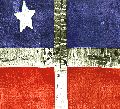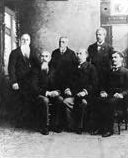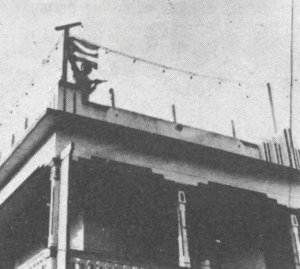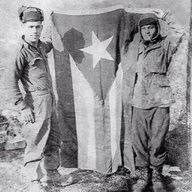Flag of Puerto Rico facts for kids
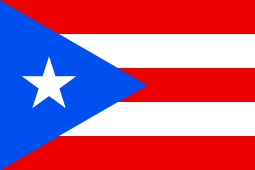 |
|
| Name | Current official flag of Puerto Rico |
|---|---|
| Proportion | 2:3 |
| Adopted | 1952 |

Variant flag of Puerto Rico
|
|
| Name | (1895 original flag version with Azul Celeste / sky blue tone) |
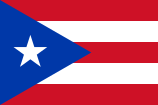
Variant flag of Puerto Rico
|
|
| Name | (1952 flag version with dark blue tone) |
| Use | Civil and state flag, civil and state ensign |
| Design | Five equal horizontal bands of red (top and bottom) alternating with white; blue equilateral triangle based on the hoist side bears a large, white, five-pointed star in the center. (Official colors of the flag) |
The flag of Puerto Rico (Spanish: Bandera de Puerto Rico) is a very important symbol. It stands for Puerto Rico and all its people.
The flag we see today became official in 1952. Its story goes back to 1868. That's when the first Puerto Rican flag, called "The Revolutionary Flag of Lares," was created. Dr. Ramón Emeterio Betances thought of the design, and Mariana Bracetti sewed it. This flag was used during a short rebellion against Spanish rule. This event, known as "El Grito de Lares," helped create a sense of Puerto Rican identity.
Later, in New York City, a group called the Revolutionary Committee of Puerto Rico adopted the Lares flag. But in 1895, they introduced a new design. This new flag looked a lot like the Cuban flag. It had five equal stripes: red, white, red, white, and red. On the left side, there was a blue triangle with a white five-pointed star.
This new flag was first flown in Puerto Rico on March 24, 1897. This happened during another revolt called the "Intentona de Yauco". For many years, it was against the law to fly the Puerto Rican flag. Only the Spanish flag (until 1898) and then the American flag (until 1952) were allowed.
In 1952, the Commonwealth of Puerto Rico made the 1895 flag design its official flag. The government at the time chose a dark blue color for the triangle. This was to match the blue in the United States flag. In 1995, the government released rules for using the flag. These rules describe the colors but don't say exactly what shade of blue to use. Because of this, you might see Puerto Rican flags with different shades of blue.
Contents
History of the Puerto Rican Flag
Early Flags Under Spanish Rule
The first flags in Puerto Rico appeared when Christopher Columbus arrived. He landed on the island and claimed it for Spain. He named it "San Juan Bautista." Columbus used the Royal Flag of Spain. His captains used white flags with a green cross and the letters 'F' and 'Y' for King Ferdinand II of Aragon and Queen Isabella I.
After Columbus, Spanish explorers led by Juan Ponce de León conquered the island. They carried the "Spanish Expedition Flag." Once Puerto Rico was a Spanish colony, the official flag of Spain was used, just like in other Spanish territories.
The Spanish army built forts like La Fortaleza and Fort San Felipe del Morro. They used a flag called the "Cross of Burgundy Flag" as their military symbol. This flag flew over all Spanish military bases.
The First Puerto Rican Flag Design
Many people in Puerto Rico wanted independence. In 1868, a leader named Ramón Emeterio Betances asked Mariana Bracetti to create a revolutionary flag. She used the flag of the Dominican Republic as an idea. The flag was divided by a white cross. The two bottom sections were red, and the two top sections were blue. There was a white star in the top left blue section.
A Puerto Rican poet, Luis Lloréns Torres, explained the flag's meaning. The white cross meant hoping for freedom. The red squares stood for the blood of heroes. The white star in the blue section represented liberty and freedom. This flag was used in the "Grito de Lares" rebellion against Spain. It was declared the national flag of the "Republic of Puerto Rico" and placed in a church. This was the first time a Puerto Rican flag was officially recognized. The original flag was taken by a Spanish officer but was later returned. Today, you can see it in the University of Puerto Rico's Museum.
In 1873, Spain changed from a kingdom to a republic. A new colonial flag was made for Puerto Rico. It looked like the Spanish flag but had the coat of arms of Puerto Rico in the middle. When Spain became a kingdom again in 1873, its flag flew over Puerto Rico once more. This lasted until 1898, when the island became part of the United States after the Spanish–American War.
The Current Flag Design
Juan de Mata Terreforte, a leader from the Grito de Lares revolt, was sent away to New York City. There, he joined the Revolutionary Committee of Puerto Rico. In 1892, this committee saw the design for what would become the current flag of Puerto Rico. Many people have been given credit for designing it.
Some say Francisco Gonzalo Marín showed a flag idea in 1895. Juan de Mata Terreforte wrote a letter saying:
"The idea of using the Cuban flag with inverted colors was suggested to me by the great patriot Francisco Gonzalo Marín in a letter he wrote from Jamaica. I presented the idea to the Puerto Rican patriots at the Chimney Hall meeting, and it was approved unanimously."
Other stories say that on June 12, 1892, Antonio Vélez Alvarado saw an optical illusion of the Cuban flag with its colors swapped. He quickly made a rough model. He showed it at a dinner where José Martí was a guest. Martí liked the idea and wrote about it in a newspaper. Later, Francisco Gonzalo Marín had a proper flag sewn based on this idea. He showed it at a meeting in New York. This flag, with its light blue triangle, soon became a symbol for Puerto Rican independence.
Maria Manuela (Mima) Besosa, whose father was in the Revolutionary Committee, said she sewed the flag. This made some people think her father might have designed it. She described the flag as having five stripes: three red and two white. On the left was a light blue triangle with a white five-pointed star.
Each part of the flag has a meaning:
- The three red stripes represent the blood of brave warriors.
- The two white stripes mean victory and peace after gaining independence.
- The white star stands for the island of Puerto Rico.
- The blue represents the sky and the ocean.
- The triangle stands for the three branches of government.
Some also believe Lola Rodríguez de Tió suggested using the Cuban flag with its colors reversed. However, the blue stripes on the Cuban flag were a darker shade.
Even though a newspaper in 1948 said Vélez Alvarado created the flag, we may never know for sure who designed it. What we do know is that on December 22, 1895, the Puerto Rican Revolutionary Committee officially adopted the design. In 1897, Antonio Mattei Lluberas brought a Puerto Rican flag to the island. On March 24, 1897, men led by Fidel Vélez carried this flag during the "Intentona de Yauco" revolt. This was the first time the flag of Puerto Rico was used on Puerto Rican soil.
When the Flag Was Outlawed
From 1898, when the United States took over Puerto Rico, until 1952, it was illegal to show the Puerto Rican flag in public. Only the flag of the United States was allowed. But the Puerto Rican flag was still used. People in the pro-independence Liberal Party and the Puerto Rican Nationalist Party often displayed it as a sign of protest. In 1932, the Nationalist Party used the flag in their elections and parades.
In 1948, the Puerto Rican legislature passed a law called Law 53. This law made it illegal to display the Puerto Rico Flag, sing patriotic songs, or talk about independence. This law was signed by Governor Jesús T. Piñero and became known as the ""Ley de la Mordaza" (Gag Law). Later that year, Puerto Ricans elected Luis Muñoz Marín as governor. During the Jayuya Uprising in 1950, members of the Nationalist party put the Puerto Rican flag on top of the town hall. A soldier later took it down.
The Flag Becomes Official
In 1952, Governor Luis Muñoz Marín and his government made the 1892 flag design the official flag of Puerto Rico. Some people thought this was a way for Muñoz Marín to calm down the independence movement. There were some small changes between the original 1892 flag and the 1952 one. The meaning of the colors was also officially changed.
Now, the white stripes stood for the republican form of government. They no longer meant victory and peace after independence. The sky-blue triangle from the original flag was changed to dark blue. This was to make it look more like the United States flag and move it away from its revolutionary past. For some, like nationalist leader Pedro Albizu Campos, having the flag represent the government was wrong. The Puerto Rican Independence Party said the government was "corrupting beloved symbols."
In 1995, the government started using the sky-blue version again. They issued new rules for the flag. These rules describe the colors but don't say exactly what shade of blue to use. So, it's common to see the flag with either a light blue or dark blue triangle in official places in Puerto Rico.
A Symbol of Pride and Protest
The flag has often been a symbol of pride. For example, during the Korean War, the Puerto Rican flag arrived in South Korea. On August 13, 1952, soldiers from Puerto Rico's 65th Infantry Regiment unfurled the flag for the first time in a foreign combat zone. The Regimental Chaplain said:
"Grant us Thy Peace and Power," the chaplain prayed for, "in this conflict against aggression and tyranny. Show us in Thy purpose Peace for all the men in the world. We dedicate this flag of the Associated Free State of Puerto Rico in Thy name."
The Commanding Officer, Colonel Juan César Cordero Dávila, said:
"How beautiful is our flag, how it looks next to the stars and the stripes! Let the communists on the other side of the Yokkok River see it and listen to me those who understand Spanish if these words reach your trenches."
The flag has also been used to show defiance and protest. In 1954, Nationalist leader Lolita Lebrón attacked the United States House of Representatives. She shouted "¡Viva Puerto Rico Libre!" ("Long live a Free Puerto Rico!") and unfurled the flag. On November 5, 2000, activists like Tito Kayak placed a Puerto Rican flag on the crown of the Statue of Liberty in New York City. This was to protest the United States Navy using the island of Vieques as a bombing range.
On March 15, 2009, several Puerto Rican flags traveled into outer space aboard the Space Shuttle Discovery. Joseph M. Acaba, the first astronaut of Puerto Rican descent, carried the flag to show his heritage. He later gave two of these flags to Governor Luis Fortuño and Secretary of State Kenneth McClintock. These flags had a darker blue triangle.
The flag is also the subject of a popular song called "Que Bonita Bandera" (What a beautiful flag). It was written in 1968 and made famous by folksinger Florencio "Ramito" Morales Ramos. Astronaut Acaba even asked for this song to be played to wake up the crew during their space flight.
Similar Flags Around the World
In the 1950s, Puerto Rico talked to Norway's Foreign Ministry. They wanted a Norwegian shipping company called Norled to stop using a flag that looked very similar to Puerto Rico's flag. Norway has not legally challenged the company, which says its flag is older than Puerto Rico's. The shipping company's flag is still in use today.
Gallery
Images for kids
-
A statue of Mariana Bracety Cuevas knitting the Puerto Rican flag is located in Añasco barrio-pueblo.
See also
 In Spanish: Bandera de Puerto Rico para niños
In Spanish: Bandera de Puerto Rico para niños



